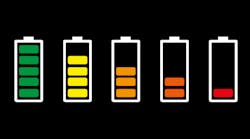Latest from Home
Detection, Prevention, and Recovery —
If you are involved in any way with the reliability of your system(s), you understand that your batteries are both your first and your last lines of defense, and thus their reliability is critical. You also understand that thermal runaway is a serious issue, as it can cause a catastrophic event, such as a fire, or site crash.
The damages might be confined to the battery, or it can be much worse. But why gamble? You don’t want the fire department to respond, given all of the nasty paperwork and other issues that go along with that. In addition, your supervisor doesn’t want to hear excuses about why YOU allowed that to occur, especially when it is universally understood that thermal runaway is easily preventable.
Batteries are the very first line of defense whenever there is even the briefest loss of AC supply to the rectifiers. They are on-line at all times, to seamlessly support the loads. That’s a good thing as your equipment does not play well when it has no power feeding it.
Batteries are also there for the long duration when your site does not have an on-site generator, or the generator fails to start when called upon. Clearly, your batteries must be reliable and predictable.
Detection and Avoidance
Thermal runaway occurs when the heat generated internally during normal charging, exceeds the ability of the battery to transfer that excess heat to the outside of itself. This is the simple definition of the issue.
In most people’s minds this is associated with Valve-Regulated Lead-Acid (VRLA) batteries, but it also occurs in Vented Lead-Acid (VLA), Ni-Cad, and, of course, in the Lithium technology. We are going to discuss only the issues with Lead-Acid batteries here because it is estimated that they are over 95% of the installed base.
Originally it was thought that thermal runaway happened without warning. While that was a common misunderstanding 20 years ago, it was incorrect. At that time, no one understood what caused it, or how obvious the warning signs were.
The good news is we know now. And, we now know how to stop it once it has started. KEY TIP! If you discover a battery in thermal runaway and it is not yet actually on fire, YOU most likely can halt it, reverse it, and get out of the situation while keeping the string in service. For guidance on how to do this go to [email protected] and ask for TR reversal aid.
Early detection is so simple that ANYONE can detect it before it puts your site at risk. You only need to understand 3 simple universal rules:
Rule 1: All lead-acid batteries in normal charging conditions should be within 2-5 degrees (F) of the normal ambient. The temperature differential between the surface of the cell/battery and the normal ambient is easily measured with a $50 temperature gun. OR, if the temperature is elevated enough, then you can measure the difference between the cells and anything that is solid that you can lay your hands on. Think about it: you can "feel" a hot surface.
Rule 2: All lead-acid batteries under normal operation conditions require from @ 0.10 – 0.5 of an amp of float current per 1,000 AH in order to maintain the cell in a fully charged condition. This is a rough estimate; some models are higher, and some are lower. Whenever you see a continuing increase, there are things going on inside your cells that you need to address.
Rule 3: Measure and record the normal Over-All String Voltage (OAV). This is an important measurement because every battery model has a "sweet spot" where the particular manufacturer wants their cells to be charged in order to maximize their life and performance. Be aware that the OAV impacts or is impacted by Rule 1 and/or Rule 2. The 4 values (ambient temp, cell temp, float current, and OAV) are all interrelated, and together can be your "canary in the mine" in that they provide you with advance warning.
Diligence Matters
It is very important to track these measurements. To do this manually, all you need is a spreadsheet. At least twice a year, measure and record the above items on that spreadsheet. Pay close attention to any changes in the current flowing through the battery string, and to the temperature differential between the cells and the normal ambient.
If you prefer to do this continuously, then install a battery monitor that alerts you to changes as they occur.
It is important to watch for CHANGES as compared to normal values. For a monitor to be effective, it needs to detect relatively small changes, as all thermal runaways start with a small change and then increase over time. For example, a Battery Event Monitor (BEM) measures only the 4 items listed earlier (ambient temp, cell temp, float current, and OAV), but because of its ability to accurately measure to tenths of an amp and within 1 degree, it provides thermal runaway prevention as well as other useful string capability information, such as voltage decay, and run time under load, as well as when the battery is fully recharged.
Prevention and Recovery
Every VRLA battery manufacturer acknowledges that dry-out is a kiss of death, and is a major contributor to Pre-mature Capacity Loss (PCL). Anything you can do to keep your VRLA cells properly saturated will help maximize their lives, capability, and help prevent thermal runaway. PCL always precedes thermal runaway.
One way to do this is by installing catalysts in the cells. Catalysts re-combine the gases being generated inside the cells back into water vapor, which helps maintain proper saturation.
Initially, catalysts were only installed in the 2-volt jars but has been expanded into the 12-volt products. Most 2-volt VRLA cells can have catalysts installed on site with the string remaining in service. One resource to use when searching for the right catalysts is Battery Research and Testing Inc. (http://batteryresearch.com)
Any VRLA battery that has properly charged negative plates, and is properly saturated, cannot go into thermal runaway. This is one of those absolute rules, sort of like gravity.
The good news is that there is a time-proven process which can be utilized to recover most batteries from PCL. That process is called the Special Recovery Process and is explained in the IEEE 1188a2014 document.
PCL was a worldwide problem, and manufacturers and users everywhere were trying to understand its cause. It was not until research led by Will Jones of Philadelphia Scientific discovered the root cause that a long-term solution to PCL was possible.
He created a catalyst that is inserted into the head space of the cells, which could be used either pro-actively or re-actively. In the re-active mode they assist with long-term recovery by lowering the required float current, which reduces the off-gassing, thus maintaining the improvements gained from the re-saturation process.
It was later discovered that a very high rate charge applied during the re-saturation process substantially improved the gains obtained. That further improvement was achieved by driving off sulfates, restoring proper plate polarizations, and recharging partially discharged cells. That finalized process, which is referred to as the IOVR process or IOVR+ process, can help improve network reliability and save OpEx over time.
Figure 1. Three components to thermal runaway prevention.
Figure 1 shows a BEM current sensor mounted on the strap going from cell two to cell three, and the cell temperature sensor affixed to the negative strap of cell two. The blue vents are the Philadelphia Scientific Cat-Vents.
The string shown had an IOVR+ performed, and the float current was reduced by over 50%, with the average conductance value improved by over 20%. That amount of improvement is within the typical range. The good news is that ANY structurally sound cell suffering from internal degradation due to PCL can see improvements.
The key to preventing thermal runaway, plus keeping your network as reliable as possible, is through proper pro-active and re-active actions as required. If you use the information provided above, as applicable to your individual systems, you can NEVER have an unexpected thermal runaway or a surprise battery failure.
Through the combined efforts of maintenance tracking, maintaining proper internal conditions, and using correctly performed recovery efforts when applicable, you will reduce potential downtime and save big dollars over the long haul.






